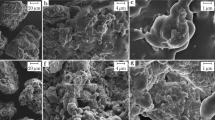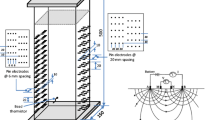Abstract
To gain insight into the process of sedimentation occurring when clay-laden estuaries and deltas enter marine water, we perform laboratory experiments to measure the settling rate of initially unflocculated kaolin clay in fresh and salt water. In fresh water, sedimentation is a slow process with the clay particle concentration gradually decreasing nearly uniformly over hours, consistent with the time-scale expected for particles falling at the Stokes settling speed. The dynamics are dramatically different for clay setting in salt water with salinities between \(S=10\) and 70 psu. Within minutes the clay particles flocculate and a sharp concentration-front between clear water (above) and water with clay in suspension (below) forms near the surface. After formation the concentration-front descends at a near constant speed until the effects of hindered settling become important. When the concentration-front forms in saline fluid, the \(10\) cm deep tank is cleared of particles in tens of minutes instead of tens of hours as is the case for settling in fresh water (\(S=0\)). The initial speed of descent of the front, \(w\), depends weakly upon salinity, \(S\), with virtually no dependence upon \(S\) provided \(S\gtrsim 20\) psu. However, the descent speed, \(w\), depends strongly upon clay concentration, \(C\), with \(w\) decreasing as \(C\) increases according to a power law: \(w \propto C^{-1.7}\). The results are consistent with observations of relatively quiescent sediment-laden estuaries and deltas where they empty into the ocean.







Similar content being viewed by others
References
Allen GP, Posamentier HW (1993) Sequence stratigraphy and facies model of an incised valley fill; the Gironde Estuary, France. J Sediment Petrol 63(3):378–391
Ani SA, Dyer KR, Huntley DA (1991) Measurement of the influence of salinity on floc density and strength. Geo-Mar Lett 11:154–158
Cerco CF, Kim SC, Noel MR (2013) Management modeling of suspended solids in the Chesapeake Bay, USA. Estuar Coast Shelf Sci 116:87–98
Choi K (2010) Rhythmic climbing-ripple cross-lamination in inclined heterolithic stratification (IHS) of a macrotidal estuarine channel, Gomso Bay, west coast of Korea. J Sediment Res 80(6):550–561
Couch MC, Hinch EJ (1991) Sedimentation, aggregation and compaction. In: Bideau D, Dodds JA (eds) Physics of Granular Media. Nova Sciences, New York, pp 299–321
Doxaran D, Froidefond JM, Castaing P, Babin M (2009) Dynamics of the turbidity maximum zone in a macrotidal estuary (the Gironde, France): observations from field and MODIS satellite data. Estuar Coast Shelf Sci 81(3):321–332
Eisma D, Cadee GC (1991) Particulate matter processes in estuaries. SCOPE 42:283–296
Geyer WR, Beardsley RC, Lentz SJ, Candela J, Limeburner R, Johns WE, Soares ID (1996) Physical oceanography of the Amazon shelf. Cont Shelf Res 16(5–6):575–616
Gibbs RJ (1977) Clay mineral segregation in the marine environment. J Sediment Petrol 47(1):237–243
Gingras MK, Pemberton SG, Saunders T, Clifton HE (1999) The ichnology of modern and pleistocene brackish-water deposits at Willapa Bay, Washington; variability in estuarine settings. Palaios 14(4):352–374
Guan WB, Kot SC, Wolanski E (2005) 3-D fluid-mud dynamics in the Jiaojiang Estuary, China. Estuar Coast Shelf Sci 65(4):747–762
Harris PT, Hughes MG, Baker EK, Dalrymple RW, Keene JB (2004) Sediment transport in distributary channels and its export to pro-deltaic environment in a tidally dominated delta: fly river, Papua New Guinea. Cont Shelf Res 24:2431–2454
Hauck TE, Dashtgard SE, Pemberton SG, Gingras MK (2009) Brackish-water ichnological trends in a microtidal barrier island-embayment system, Kouchibouguac National Park, New Brunswick, Canada. Palaios 24(8):478–496
Hicks DM, Gomez B, Trustrum NA (2004) Event suspended sediment characteristics and the generation of hyperpycnal plumes at river mouths: East coast continental margin, north island, New Zealand. J Geol 112:471–485
Hovikoski J, Rasanen M, Gingras MK, Ranzi A, Melo J (2008) Tidal and seasonal controls in the formation of late Miocene inclined heterolithic stratification deposits, western Amazonian foreland basin. Sedimentology 55(3):499–530
Khelifa A, Hill PS (2006) Models for effective density and settling velocity of flocs. J Hydraul Res 44(3):390–401
Krone RB (1962) Flume studies of the transport of sediment in estuarial shoaling processes. Tech. Rep. Final Report, Hydraulic Engineering Laboratory and Sanitary Engineering Research Laboratory, University of California, Berkeley
Krone RB (1993) Sedimentation revisited. In: Mehta AJ (ed) Nearshore and Estuarine Cohesive Sediment Transport, Coastal and Estuarine Studies. Americal Geophysical Union, pp 108–125
Kynch G (1952) A theory of sedimentation. Trans Faraday Soc 48:166–176
Lamb MP, Mohrig D (2009) Do hyperpycnal-flow deposits record river flood dynamics. Geology 37(12):1067–1070
Lau YI, Krishnappan BB (1994) Does re-entrainment occur during cohesive sediment settling? J Hydraul Eng 120(2):236–244
Mehta AJ (1986) Characterization of cohesive sediment properties and transport processes in estuaries. In: Mehta AJ (ed) Estuarine Cohesive Sediment Dynamics, vol 14, Lecture Notes in Coastal and Estuarine StudiesSpringer, Berlin, pp 290–325
Mitchell SB, Lawler DM, West JR, Couperthwaite JS (2003) Use of continuous turbidity sensor in the prediction of fine sediment transport in the turbidity maximum of the Trent Estuary, UK. Estuar Coast Shelf Sci 58:645–652
Parchure TM, Mehta AJ (1985) Erosion of soft cohesive sediment deposits. J Hydraul Eng 111(10):1308–1326
Ross MR, Mehta AJ (1989) On the mechanics of lutoclines and fluid mud. J Coast Res 5:51–62
Sanford LP, Halka JP (1993) Assessing the paradigm of mutualy exclusive erosion and deposition of mud with examples from upper Chesapeake Bay. Mar Geol 114:37–57
Schieber J, Southard J, Thaisen K (2007) Accretion of mudstone beds from migrating floccule ripples. Science 318:1760–1763
Shi Z, Kirby R (2003) Observations of fine suspended sediment processes in the turbidity maximum at the north passage of the Changjiang Estuary, China. J Coast Res 19(3):529–540
Sisulak C, Dashtgard S (2012) Seasonal controls on the development and character of inclined heterolithic stratification in a tide-influenced, fluvially dominated channel; Fraser River, Canada. J Sediment Res 82(4):244–257
Travkovski P, Wiberg PL, Geyer WR (2007) Observations and modeling of wave-supported sediment gravity flows on the Po prodelta and comparison to prior observations from the Eel Shelf. Cont Shelf Res 27:375–399
Uncles RJ, Smith RE (2005) A note on the comparative turbidity of some estuaries of the americas. J Coast Res 21(4):845–852
Uncles RJ, Stephens JA, Law DJ (2006) Turbidity maximum in the macrotidal, highly turbid Humber Estuary, UK; flocs, fluid mud, stationary suspensions and tidal bores. Estuari Coast Shelf Sci 67(1–2):30–52
Winterwerp JC (2002) On the flocculation and settling velocity of estuarine mud. Cont Shelf Res 22:1339–1360
Winterwerp JC (2007) On the sedimentation rate of cohesive sediment. In: Maa JPY, Sanford LP, Schoellhamer DH (eds) Estuarine and coastal fine sediment dynamics. Elsevier, Amsterdam, pp 209–226
Acknowledgments
This research was supported by the National Science and Engineering Research Council of Canada (NSERC).
Author information
Authors and Affiliations
Corresponding author
Electronic supplementary material
Below is the link to the electronic supplementary material.
Rights and permissions
About this article
Cite this article
Sutherland, B.R., Barrett, K.J. & Gingras, M.K. Clay settling in fresh and salt water. Environ Fluid Mech 15, 147–160 (2015). https://doi.org/10.1007/s10652-014-9365-0
Received:
Accepted:
Published:
Issue Date:
DOI: https://doi.org/10.1007/s10652-014-9365-0




